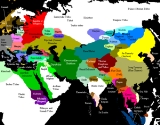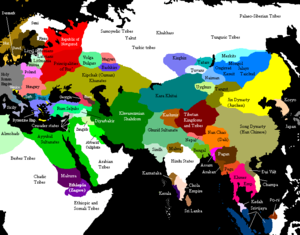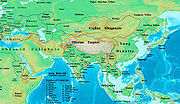
Nanzhao
Encyclopedia

Pinyin
Pinyin is the official system to transcribe Chinese characters into the Roman alphabet in China, Malaysia, Singapore and Taiwan. It is also often used to teach Mandarin Chinese and spell Chinese names in foreign publications and used as an input method to enter Chinese characters into...
: Nánzhào; ) was a polity that flourished in what is now southern China and Southeast Asia
Southeast Asia
Southeast Asia, South-East Asia, South East Asia or Southeastern Asia is a subregion of Asia, consisting of the countries that are geographically south of China, east of India, west of New Guinea and north of Australia. The region lies on the intersection of geological plates, with heavy seismic...
during the 8th and 9th centuries. It was centered around present-day Yunnan
Yunnan
Yunnan is a province of the People's Republic of China, located in the far southwest of the country spanning approximately and with a population of 45.7 million . The capital of the province is Kunming. The province borders Burma, Laos, and Vietnam.Yunnan is situated in a mountainous area, with...
in China
China
Chinese civilization may refer to:* China for more general discussion of the country.* Chinese culture* Greater China, the transnational community of ethnic Chinese.* History of China* Sinosphere, the area historically affected by Chinese culture...
.
Founding and ethnography

Erhai Lake
Er Lake, Chinese Erhai , is an alpine fault lake in Yunnan province, China. Its name means "Ear-shaped Sea", due to its shape as seen by locals and travellers. Er Lake was also known as Yeyuze or Kunming Lake in ancient times. A commonly-seen mistranslation is Erhai Lake.-Geography:Erhai is...
. These tribes were called Mengshe (蒙舍), Mengsui (蒙嶲), Langqiong (浪穹), Dengtan (邆賧), Shilang (施浪), and Yuexi (越析). Each tribe had its own kingdom, known as a zhao. In 649 AD the chieftain of the Mengshe tribe, Xinuluo (細奴邏), founded a kingdom (Damengguo 大蒙國) in the area of Lake Erhai. In the year 737 CE, with the support of the Tang Dynasty
Tang Dynasty
The Tang Dynasty was an imperial dynasty of China preceded by the Sui Dynasty and followed by the Five Dynasties and Ten Kingdoms Period. It was founded by the Li family, who seized power during the decline and collapse of the Sui Empire...
of China, Piluoge(皮逻阁)united the six zhaos in succession, establishing a new kingdom called Nanzhao (Mandarin, "Southern Zhao").
Nanzhao was made up of many ethnic and linguistic groups. Some historians believe that the majority of the population were of the Bai people, but that the elite spoke a variant of Nuosu (also called Yi), a Tibeto-Burman language closely related to Burmese
Burmese language
The Burmese language is the official language of Burma. Although the constitution officially recognizes it as the Myanmar language, most English speakers continue to refer to the language as Burmese. Burmese is the native language of the Bamar and related sub-ethnic groups of the Bamar, as well as...
. In any case, the capital was established in 738 at Taihe
Taihe
Taihe may refer to::*Taihe County, Anhui , in Fuyang, Anhui*Taihe County, Jiangxi , in Ji'an, Jiangxi*Taihe District , Jinzhou, Liaoning*Princess Taihe, princess during the Tang DynastySubdistricts...
(modern day Taihe village, a few miles south of Dali
Dali, Yunnan
Dali City is a county-level city in and the seat of the Dali Bai Autonomous Prefecture, northwestern Yunnan province of Southwest China.-History:...
). Located in the heart of the Erhai valley, the site was ideal: it could be easily defended against attack, and it was in the midst of rich farmland.
Nanzhao came under Tibetan control from 680 CE. The Tibetans recognised its suzerainty
Suzerainty
Suzerainty occurs where a region or people is a tributary to a more powerful entity which controls its foreign affairs while allowing the tributary vassal state some limited domestic autonomy. The dominant entity in the suzerainty relationship, or the more powerful entity itself, is called a...
after 703 and then took it under their control again from 750-794, when Nanzhao turned on their Tibetan overlords and helped China defeat their armies.
Religion
Nanzhao had a strong connection with Theravada Buddhism, as evidenced by surviving stone carvings, as well as temples from the period. Some scholars are said to have claimed that Nanzhao's Acarya Buddhism was related to the TantricTantra
Tantra , anglicised tantricism or tantrism or tantram, is the name scholars give to an inter-religious spiritual movement that arose in medieval India, expressed in scriptures ....
Ari Buddhism
Ari Buddhism
Ari Buddhism is the name given to the religious practice common in Burma, prior to Anawrahta's rise and the subsequent conversion of Bagan to Theravada Buddhism in the eleventh century. It was introduced in the 7th century, possibly through trade contact from India or Tibet...
of Bagan
Bagan
Bagan , formerly Pagan, is an ancient city in the Mandalay Region of Burma. Formally titled Arimaddanapura or Arimaddana and also known as Tambadipa or Tassadessa , it was the capital of several ancient kingdoms in Burma...
, Myanmar
Myanmar
Burma , officially the Republic of the Union of Myanmar , is a country in Southeast Asia. Burma is bordered by China on the northeast, Laos on the east, Thailand on the southeast, Bangladesh on the west, India on the northwest, the Bay of Bengal to the southwest, and the Andaman Sea on the south....
.
Expansion
In 750, Nanzhao rebelled against the Tang Dynasty. In retaliation, the Tang sent an army against Nanzhao in 751, but this army was soundly defeated at XiaguanXiaguan
Xiaguan may refer to the following locations in China:*Xiaguan District , Nanjing, Jiangsu*Xiaguan, Neixiang County , town in Neixiang County, Henan*Xiaguan, Dali City , town in Yunnan...
. (It was in the same year that the Tang suffered another serious defeat at the hands of the Arabs at the Battle of Talas
Battle of Talas
The Battle of Talas in 751 AD was an especially notable conflict between the Arab Abbasid Caliphate and the Chinese Tang Dynasty for control not only of the Syr Darya region, but even more...
in Central Asia
Central Asia
Central Asia is a core region of the Asian continent from the Caspian Sea in the west, China in the east, Afghanistan in the south, and Russia in the north...
; these defeats weakened the dynasty both internally and externally.) Today the General's Cave (two kilometres west of Xiaguan), and the Tomb of Ten Thousand Soldiers (in Tianbao Park) bear witness to this great massacre. In 754, another Tang army was sent, this time from the north, but it too was defeated (and Tang was unable to send another expedition due to the outbreak of Anshi Rebellion in the following year). Bolstered by these successes, Nanzhao expanded rapidly, first into Burma, then into the rest of Yunnan, down into northern Laos
Laos
Laos Lao: ສາທາລະນະລັດ ປະຊາທິປະໄຕ ປະຊາຊົນລາວ Sathalanalat Paxathipatai Paxaxon Lao, officially the Lao People's Democratic Republic, is a landlocked country in Southeast Asia, bordered by Burma and China to the northwest, Vietnam to the east, Cambodia to the south and Thailand to the west...
and Thailand
Thailand
Thailand , officially the Kingdom of Thailand , formerly known as Siam , is a country located at the centre of the Indochina peninsula and Southeast Asia. It is bordered to the north by Burma and Laos, to the east by Laos and Cambodia, to the south by the Gulf of Thailand and Malaysia, and to the...
, and finally, north into Sichuan
Sichuan
' , known formerly in the West by its postal map spellings of Szechwan or Szechuan is a province in Southwest China with its capital in Chengdu...
. In 829, Chengdu
Chengdu
Chengdu , formerly transliterated Chengtu, is the capital of Sichuan province in Southwest China. It holds sub-provincial administrative status...
was taken; it was a great prize, as it enabled Nanzhao to lay claim to the whole of Sichuan province, with its rich paddy fields. This was too much for the Tang Dynasty, who lost no time in counterattacking.
Decline
By 873, Nanzhao had been expelled from Sichuan, and retreated back to Yunnan. Taking Chengdu marked the high point of the Nanzhao kingdom, and it was a watershed: from then on, the Nanzhao Kingdom slowly declined.Overthrow
In 902, the Nanzhao dynasty was overthrown. The end was bloody, for in that year the chief minister murdered all of the key members of the royal family, including the heir apparent. This was followed by three other dynasties in quick succession, though it was difficult to tell these from chaos. Duan SipingDuan Siping
Duan Siping was a statesman of Bai origin and eventual founder and ruler of the Kingdom of Dali. The Kingdom retained independence from unified China until the Mongol invasion in 1253 C.E....
seized power in 937 to establish the Kingdom of Dali
Kingdom of Dali
Dali or Great Li was a Bai kingdom centred in what is now Yunnan Province of China. Established by Duan Siping in 937, it was ruled by a succession of 22 kings until the year 1253, when it was conquered by an invasion of the Mongol Empire. The capital city was at Dali.- History :The Kingdom of...
.

